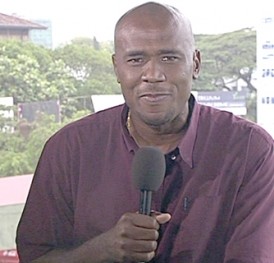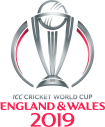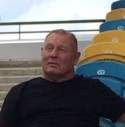Interview with Ian Bishop
Ganeshbabu Venkat |
In this latest chat with Cricket Web former West Indian fast bowler Ian Bishop talks about his playing days, career, formative days and fast bowling in general.You can find the 2010 interview here
[CW] Hi Bish, please talk to us about your early days.
[IB] I picked up fast bowling during the later part of my secondary school at Belmont intermediate; I primarily started off as an opening batsman, in one of the school final tournaments against Fatima College (Brian Lara was playing for this team) – I was the captain for Belmont. One of my opening bowlers fell ill, and I decided to bowl myself.
I started off as an off-spinner and gradually stretched my run up and made some good progress that year. As I got into bowling, and grew taller and started to bowl more, I realized that my bowling superseded my batting. In 1986-87, I went to England as a part of the schools program scholarship, where I found out what I could do with my bowling.
[CW] What about getting in to the West Indies team and graduating as a fast bowler?
[IB] My transition was not charted; I was fortunate enough to go on a scholarship to England, and when I came back in 1987, I was called into the Trinidad and Tobago trials for the senior team. I did not expect to get in to the team, but I made it. I had a lot of guidance from a number of guys during that initial grounding period, like Phil Simmons, who became a very close friend of mine, and Kelvin Williams who was also a mentor for me at the national level.
I also trained with my school team mates running around the Queen’s Park Savannah and the hills at the chancellor here in Port of Spain. In 1989, I met Michael Holding at Derbyshire, and he coached me, and of course when I broke in to the West Indies side, Malcolm Marshall and Courtney Walsh were there during that early period. Malcolm was my primary mentor and had this “hand on shoulder approach” with me during my initial tours to England and Australia.
[CW] Please tell us about your Test debut, the stress fracture and its effect
[IB] It was a difficult period, and it was a difficult transition for me. I toured England and Australia with the West Indies in 1988, but did not get to play my first Test till the Indian tour of 1989 at Guyana. Fast bowling by then was natural for me – my body had developed significantly, and I had a decent understanding of the technique from these guys. I had a decent debut series and performed reasonably well.
By the time, I had the stress fracture in 1991, right after the Pakistan tour in 1990, it became tough. Initially no one could tell me why I was getting the pain in my back, and eventually I got through by the grace of God, friends around me etc., but coming back was never the same, it just was not. As much as I wanted to bowl quickly my body would not allow me since I had modified my action, so I tried to compensate for the lack of pace with control and bowling was never the same again for me.
[CW] How did you as a fast bowler unsettle a batsman?
[IB] A fast bowler by nature is unsettling; I’m talking about speeds of 85 mph and above. That pace is unsettling. What a bowler should learn to do is when to be aggressive, when to bowl short, when to throttle down your speed and bowl a more consistent line and length. That comes from experience, but for younger bowlers that comes from talking to guys who have been there before.
For me most of the bowling itself was spontaneous. Sometimes I get to the top of my mark, I turn around and get an instinct that this particular delivery should be an out swinger, yorker or a short ball. Lots of things bowlers do on the field is also pre-planned based on their knowledge of the batsman, video analysis and homework. The bottom line though is a bowler should be able to assess the condition of the pitch, situation of the match and have the ability to think on their feet. Halfway through the run up sometimes I have changed plans – when the grip feels good and the body feels good, I’m going to do something different than what I thought I wanted to do originally.
[CW]What would you say are the requirements to be a good fast bowler?
[IB] There are a number of things; good run up, strengths of that bowler, quick arm, strong shoulder action, rhythmical approach a la Ambrose, run up, pace at the run up, momentum, approach to the crease etc. Of course fitness and stamina and the willingness to work hard; fast bowling is very hard work. I do not think there is a more demanding aspect in cricket than bowling 20 overs a day or bowling at the death in an ODI. Those skills combined with good technique are very valuable for an aspiring fast bowler.
[CW] The art of reverse swing; was it only restricted to the Pakistanis?
No. We did it too (laughs). I remember this happened more during the second half of my career; we found out about it by accident, when the pitch is dry with very little grass, and the ball is about 35-40 overs old, and that was the time the ball would start doing something [reversing]. It was not happening in moist, green conditions. Having played with Waqar Younis and those guys we were very well aware of it, but I never came to grips with it until the second half/latter half of my career.
[CW] What do you think about ball tampering and should it be made legal?
[IB] I think ball tampering is not a figment of anyone’s imagination. Ball tampering has gone on for a while. Even in county cricket, guys have always been looking for ways to extract something extraordinary with the ball, whether it was by using liquids, sweets or something else. Some guys used lip guards. Apart from the inquisitiveness during the initial days in WI cricket, I do not think any of the guys whom I played with ever did any of that stuff.
I think it should not be made legal. There is a great satisfaction and integrity playing within the laws of the game and guys have performed admirably within legal limits. Another issue is if scratching is allowed, where do we stop? For guys to say now let’s allow ball tampering, so bowlers get some advantage – the game has always been hard. Wickets are a lot flatter now; it was flat during our days too. I do not buy that excuse of let’s legalize ball tampering to make the game even.
[CW] Whom do you rate as the best fast bowler you have seen?
[IB] Malcolm Marshall without a doubt was the best bowler I have seen. I remember times standing at mid-off or mid-on during the time he took me under his wing, and he would ask me to go to my left or go to my right and he would tell me what he was going to bowl, and he would execute it to perfection. Of course, I did not play with him during his heyday, but still it was phenomenal to see him bowl, I learnt to set fields, creating opportunities and bowling angles from him. He was just brilliant.
[CW] Talking of regrets, do you have any?
[IB] Not really. I was glad to have played at that level for such a long period and playing with the guys that I played with. The memories of playing with the likes of Richards, Walsh, Dujon, Marshall are just irreplaceable.
Ganesh Venkat,CW staff member interviewed Bish on behalf of CW. His Twitter feed is here





Leave a comment